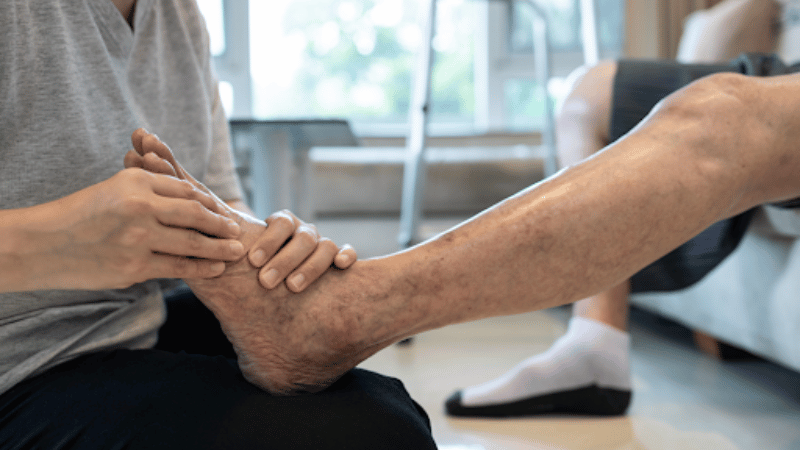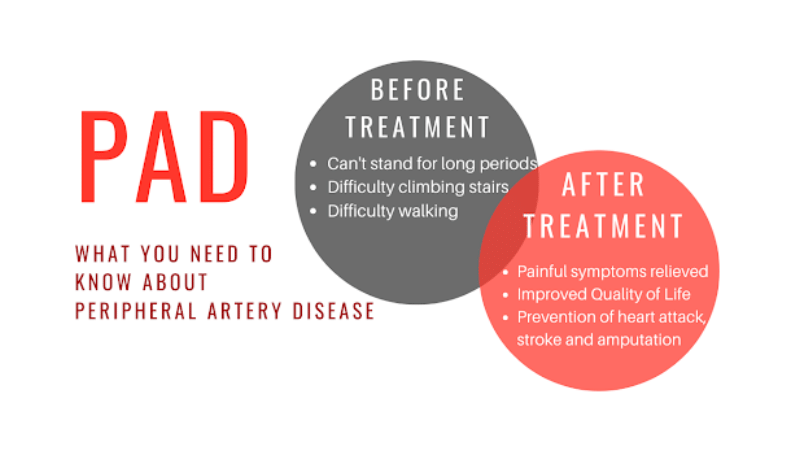It’s estimated that around 46 million U.S. adults smoke cigarettes or e-cigarettes.¹ This is a common vice that can negatively impact your health, especially if you suffer from vascular diseases like peripheral artery disease (PAD). If you’re a smoker, there are many risk factors and complications you’ll want to be mindful of so you know when to seek help or start considering making lifestyle changes.
Here’s everything you need to know about smoking and peripheral artery disease (PAD).
PAD and Smoking: Does Smoking Cause PAD?
Understanding the connection between your health and peripheral arterial disease (PAD) is important for everyone, including smokers. Smoking is a major risk factor for PAD, but it’s not the only one. This information can help you make informed decisions about your health.
The risk of developing PAD is complicated, but studies indicate that smoking is a contributing factor. PAD is estimated to affect anywhere from three to ten percent the population, but it increases to almost 20% in patients who smoke, have diabetes, or are elderly.² Even secondhand smoke can contribute to your vascular health if you spend enough time around it.
Maintaining healthy blood flow to your legs is important for everyone. PAD is a condition where plaque buildup, a fatty substance, narrows or blocks arteries in your legs, limiting blood flow. Smoking is a significant risk factor for PAD, meaning that you are more likely to develop the disease.
“When you smoke, the nicotine causes your arteries to constrict and become narrower, which reduces the amount of blood flow further,” states Yan Katsnelson, M.D., Founder and CEO of USA Vascular Centers.
If you smoke or have concerns about PAD, talk to a vascular specialist. They can assess your risk factors and discuss options to manage your help, including smoking cessation programs that can significantly benefit your overall health and potentially improve your PAD symptoms.
How Is Smoking Related to Peripheral Artery Disease?
Smoking is one of the most correlated risk factors for PAD. Nicotine, for example, causes the blood vessels to constrict, reducing blood flow. Studies have found that artery thickening occurred more frequently in people who smoked over 90 percent of those who smoked more than two packs per day experiencing advanced thickening.² Nearly half of those who smoked less than a pack a day also suffered from thickened arteries.
The chemicals in cigarettes also impact blood flow and causing:
- Blood clots to form
- Coagulation; making your blood thicker
- Disruption in platelet function; affecting how well the blood cells clump together to stop bleeding
All of these issues affect how blood flows through the arteries. Because smoking can impact blood flow, it can either be a factor that leads to PAD or exacerbate the condition after it has been diagnosed.
What is Smoker’s Leg?
A smoker’s leg is a PAD symptom caused by a reduction in blood flow in the legs. This decrease in blood flow can cause leg pain while walking and cramping in the legs, thighs, or buttocks. Smoker’s leg is a common symptom for smokers with PAD. It can also be caused by high blood pressure, obesity, or chronic kidney disease.
If you have leg pain while walking and notice other symptoms like leg weakness, hair loss, or shiny skin, we recommend scheduling a consultation with a vascular doctor. These are all signs that point to PAD smoker’s leg. PAD is a serious vascular disease that requires treatment.
Complications of Smoking and PAD
Smoking can speed up the effects of PAD, which can lead to even more serious health issues. Yan explains, “Nicotine causes the arteries to tighten, while tobacco smoke lowers good cholesterol and raises bad cholesterol. High levels of bad cholesterol are a risk factor in getting PAD because it can increase plaque buildup.”
When a person with PAD continues to smoke, they are at a greater risk for the following:
- Graft failure
- Amputation
- Heart attack
- Death
Can Quitting Smoking Reverse PAD?
If you have been diagnosed with PAD or suspect that you have this condition, it is highly recommended to stop smoking. Although quitting smoking can be a difficult journey, this lifestyle change may stop the progression of your symptoms.
A study from the U.S. National Library of Medicine found patients who stopped smoking didn’t develop new signs of claudication, a common symptom of PAD. In contrast, those who continued to smoke saw a progression in PAD.4 Claudication is pain or weakness in the legs that starts with physical activity and stops within minutes of resting; it is also a common symptom of peripheral artery disease.
While quitting smoking is crucial for managing PAD, it cannot completely reverse the existing plaque buildup. Early diagnosis and proper treatment, including smoking cessation, can improve your quality of life. However, smokers who are worried about their vascular health should consider scheduling a consultation with their doctor. A medical provider will provide a treatment plan and course of action that aligns with your medical needs.
Consulting with a vascular specialist is essential for anyone with PAD, regardless of their smoking status. Treatment is the best solution for combating the effects of PAD and alleviating pain associated with the symptoms.
What are the Benefits of Quitting Smoking?
If you are a smoker and concerned about PAD, quitting smoking is one of the best decisions you can make for your health. While quitting may not guarantee complete recovery, it can significantly slow down the progression of PAD, reduce your risk of complications, and improve your overall health.
It’s important to consult a doctor if you have concerns about PAD, regardless of your smoking status. They can assess your individual risk factors and recommend the best course of treatment, including smoking cessation support.
Remember, quitting smoking is a journey, and there will be challenges. Talk to your doctor about resources and support programs available to help you quit. Below are benchmarks to help you understand how to improve your health by quitting smoking:
24 Hours
Within 24 hours, your heart rate decreases, effectively reducing your risk of developing heart disease.
Three Months
Within three months of cessation, circulation begins to improve because the walls of the arteries become thinner and healthier again. During this time, the lungs start to heal, and you may notice an improvement in physical endurance. As you feel better and more active, you may also notice an improvement in PAD smoker’s leg.
Five Years
Within five years of smoking cessation, your arteries and veins widen, reducing the risk of clotting. Because the impact on your arteries is reversed, quitting smoking can minimize your risk of developing PAD.
The benefits of quitting smoking are long-lasting. Former smokers who have been smoke-free for 20 years can enjoy the same risk of death from smoking-related causes as someone who has never smoked.
Quitting smoking is the single most important lifestyle change you can make if you have PAD. While quitting may not completely cure PAD, it can significantly slow down its progression, reduce your risk of complications and improve your overall health.
PAD Treatments for Smokers
If you’re a smoker, have a history of smoking, or have already been diagnosed with PAD, your doctor may recommend treatment to improve blood flow and prevent progression of the disease. At USA Vascular Centers, our main PAD treatment goals are to reduce symptoms and improve mobility. We offer three types of non-surgical treatment for PAD:
- Stent Placements: This is a minimally invasive treatment where a small tube is placed in the arteries and is designed to help open up blocked or narrowed arteries.
- Angioplasty: Angioplasty is a non-surgical treatment where an IV and a catheter is inserted. The catheter has a small balloon attached to the top. The balloon is inflated to help compress plaque in the arteries and improve blood flow.
- Atherectomy: An atherectomy uses a laser or a tiny blade to compress plaque inside the arteries. This is a minimally invasive procedure that also has a low risk of infection.
Treatment can help reduce symptoms, improve mobility, and lower your risk of heart attack or stroke.
Schedule a Consultation With USA Vascular Centers
If you are a smoker and have been diagnosed with PAD, USA Vascular Centers can help. We provide non-surgical treatments that can help improve your quality of life and allow you to lead an active lifestyle again.
You can call us at 888.723.2193 or schedule an appointment online to visit one of our centers.
Sources Cited
- Tobacco Product Use Among Adults – United States, 2021. (n.d.). National Library of Medicine.
- EC;, A. O. H. L. (n.d.). Cigarette smoking and coronary artery disease. A macroscopic and microscopic study. Chest.
- Fritschi, C., Collins, E. G., O’Connell, S., McBurney, C., Butler, J., & Edwards, L. (2013). The effects of smoking status on walking ability and health-related quality of life in patients with peripheral arterial disease. The Journal of cardiovascular nursing.
- Department of Surgery, Imperial College School of Medicine, Charing Cross Hospital, London W6 8RF . The practical management of claudication.




